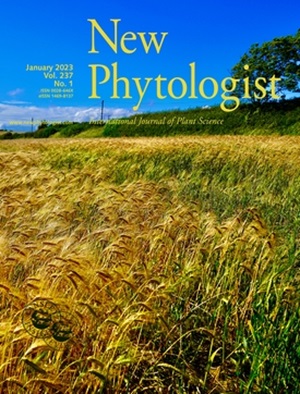A barley MLA immune receptor is activated by a fungal nonribosomal peptide effector for disease susceptibility
IF 8.3
1区 生物学
Q1 PLANT SCIENCES
引用次数: 0
Abstract
- The barley Mla locus contains functionally diversified genes that encode intracellular nucleotide-binding leucine-rich repeat receptors (NLRs) and confer strain-specific immunity to biotrophic and hemibiotrophic fungal pathogens.
- In this study, we isolated a barley gene Scs6, which is an allelic variant of Mla genes but confers susceptibility to the isolate ND90Pr (BsND90Pr) of the necrotrophic fungus Bipolaris sorokiniana. We generated Scs6 transgenic barley lines and showed that Scs6 is sufficient to confer susceptibility to BsND90Pr in barley genotypes naturally lacking the receptor. The Scs6-encoded NLR (SCS6) is activated by a nonribosomal peptide (NRP) effector produced by BsND90Pr to induce cell death in barley and Nicotiana benthamiana. Domain swaps between MLAs and SCS6 reveal that the SCS6 leucine-rich repeat domain is a specificity determinant for receptor activation by the NRP effector.
- Scs6 is maintained in both wild and domesticated barley populations. Our phylogenetic analysis suggests that Scs6 is a Hordeum-specific innovation.
- We infer that SCS6 is a bona fide immune receptor that is likely directly activated by the nonribosomal peptide effector of BsND90Pr for disease susceptibility in barley. Our study provides a stepping stone for the future development of synthetic NLR receptors in crops that are less vulnerable to modification by necrotrophic pathogens.
大麦MLA免疫受体被真菌非核糖体肽效应物激活,影响疾病易感性
大麦Mla位点包含功能多样化的基因,这些基因编码细胞内核苷酸结合富亮氨酸重复受体(NLRs),并赋予菌株对生物营养和半生物营养真菌病原体的特异性免疫。在这项研究中,我们分离了一个大麦基因Scs6,该基因是Mla基因的等位变异,但对坏死性真菌双极真菌的ND90Pr (BsND90Pr)具有易感性。我们培育了Scs6转基因大麦株系,发现Scs6足以使天然缺乏该受体的大麦基因型对BsND90Pr产生易感性。SCS6编码的NLR (SCS6)被BsND90Pr产生的非核糖体肽(NRP)效应物激活,诱导大麦和烟叶细胞死亡。MLAs和SCS6之间的结构域交换表明,SCS6富含亮氨酸的重复结构域是NRP效应物激活受体的特异性决定因素。Scs6在野生和驯化大麦种群中均有存在。我们的系统发育分析表明,Scs6是hordeum特有的创新。我们推断SCS6是一种真正的免疫受体,可能被BsND90Pr的非核糖体肽效应物直接激活,从而导致大麦的疾病易感性。我们的研究为未来在作物中开发不易受坏死性病原体修饰的合成NLR受体提供了一个踏脚石。
本文章由计算机程序翻译,如有差异,请以英文原文为准。
求助全文
约1分钟内获得全文
求助全文
来源期刊

New Phytologist
生物-植物科学
自引率
5.30%
发文量
728
期刊介绍:
New Phytologist is an international electronic journal published 24 times a year. It is owned by the New Phytologist Foundation, a non-profit-making charitable organization dedicated to promoting plant science. The journal publishes excellent, novel, rigorous, and timely research and scholarship in plant science and its applications. The articles cover topics in five sections: Physiology & Development, Environment, Interaction, Evolution, and Transformative Plant Biotechnology. These sections encompass intracellular processes, global environmental change, and encourage cross-disciplinary approaches. The journal recognizes the use of techniques from molecular and cell biology, functional genomics, modeling, and system-based approaches in plant science. Abstracting and Indexing Information for New Phytologist includes Academic Search, AgBiotech News & Information, Agroforestry Abstracts, Biochemistry & Biophysics Citation Index, Botanical Pesticides, CAB Abstracts®, Environment Index, Global Health, and Plant Breeding Abstracts, and others.
 求助内容:
求助内容: 应助结果提醒方式:
应助结果提醒方式:


